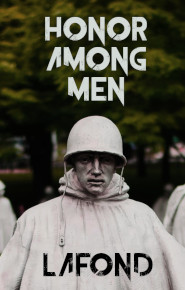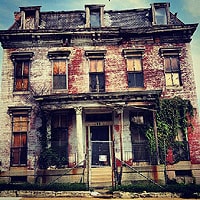This day and the next, the enemy were employed in making gabions [retaining wall constructed of baskets of stones tied together], faueissons [?], and fascines [brush bundles for strengthening earthworks], and in cutting a road across the woods, from the place of landing, to the place where the trenches were to be opened; and the second division of the enemy arriving on the 11th in the morning, with the artillery and provisions, the same immediately landed without any opposition. Though dispositions were made for opening the trenches on the 10th at night, which was rather a parallel of about 100 toises [a French measure, and contains about two fathoms, or six feet in length] in front, and opened at the distance of about 60 toises from the foss [waterfall] of Fort Ontario, in ground embarrassed with trunks of trees.
About five in the morning of the 1 1th, this parallel was finished, and the workmen began to erect the batteries. Thus was the place invested by about 5,000 men, and 32 pieces of cannon, from 12 to 18 pounders, besides several large brass mortars and hoyets [howitzers?], among which artillery was part of General Braddock's [captured in his defeat by the Indians in Western Pennsylvania].
About nine they began the attack of Fort Ontario, with small arms, which was briskly returned. All this day, the garrison was employed on the west side of the river, in repairing the batteries on the south side of the Old Fort.
The next morning (the 12th) at day-break, a large number of French batteaux were discovered on the lake, in their way to join the enemy's camp: on which, Colonel Mercer ordered the two sloops to be again sent out, with directions to get between the batteaux and the camp: but before our vessels came up, the batteaux had secured themselves under the fire of their cannon.
In the evening, a detachment was made of 100 men of the 50th (General Pepperells) regiment, and 126 of the New Jersey provincials, under the command of Colonel Schuyler, to take possession of the fort on the hill, to the westward of the Old Fort, and under the direction of the engineer, Mr M'Kneller, were to put it into the best state of defence they could; in which work they were employed all the following night.
The enemy on the east side continued their approaches to the Fort Ontario, but, with their utmost efforts, for a long time they could not bring their cannon to bear on it. However, drawing their cannon with great expedition, next morning (the 13th) about ten o'clock, to a battery erected with- in sixty yards from it, they played them very hotly on the garrisons notwithstanding the constant fire kept on them, and the loss of their principal engineer, who was killed in the trenches. A council of war was immediately held, by the officers of General Pepperel's regiment, who, observing the mortars were beginning to play, concluded it most advisable to quit Fort Ontario, and join Colonel
Schuyler's regiment at Fort George or Fort Rascal; and an account of this latter battery being sent to Colonel Mercer, by the commandant of the enemy, ordering him to evacuate the fort, they accordingly did, about three in the afternoon, destroying the cannon, ammunition, and provisions therein, and managed their retreat so as to pass the river, and join the troops at the west side, without the loss of a man. These troops, being about 370, were immediately ordered to join Colonel Schuyler, which they accordingly did, and were employed all the following night in completing the works of that fort.
M. Montcalm immediately took possession of Fort Ontario, and ordered the communications of the parallel to be continued to the banks of the river, where, in the beginning of the night, they began a grand battery, placed in such a manner that it could not only batter Fort Oswego, and the way from thence to Fort George, but also the entrenchment of Oswego.
In the morning of the 13th, the large brigantine being off the rocks and repaired, a detachment of eighty men of the garrison was put on board of her and the two sloops, in order to go out immediately; but the wind continuing to blow directly into the harbour, rendered it impossible for them to get out before the place was surrendered. This night, as well as the night before, parties of the enemy's irregulars made several attempts to surprise our advanced guards and sentinels, on the west side of the river, but did not succeed in any of them.
The enemy were employed this night, in bringing up their cannon, and raising a battery. On our side we kept a constant fire of cannon and shells from the Old Fort, and works about it. The cannon which most annoyed the enemy were four pieces, which we reversed on the platform of an earthen work, which surrounded the Old Fort, and which was entirely enfiladed [a raking fire into the side of a position or along the long axis of a body of men] by the enemy's battery on the opposite shore: In this situation, without the least cover, the train, assisted by a detachment of Shirley's regiment, behaved remarkably well.
At day-break, on the 14th, we renewed our fire on that part of the opposite shore, where we had the evening before observed the enemy at work, in raising the battery.
The enemy, in three columns, consisted of 2500 Canadians and savages, crossed the river, some by swimming, and others by wading, with the water up to their middles, in order to invest [isolate] and attack the Old Fort. This bold action, by which they entirely cut off the communication of the two forts; the celerity with which the works were carried on, in ground that we thought impracticable: a continual return of our fire from a battery of ten cannon, twelve pounders; and their preparing a battery of mortars and hoyets, made Colonel Mercer think it advisable (he not knowing their numbers) to order Colonel Schuyler, with 500 men, to oppose them; which would accordingly have been carried into execution, and consequently, every man of the 500 cut off, had not Colonel Mercer been killed by a cannon ball, a few minutes after. The resolution of this valiant Colonel seemed to be determined to oppose the French to the last extremity, and to maintain his ground at Oswego, but his final doom came on so unexpectedly, that his loss was universally regretted.
About ten o'clock, the enemy's battery was ready to play; at which time, all our places of defence were either enfiladed, or ruined by the constant fire of their cannon; Fort Rascal, or George, in particular, having at that time no guns, and scarce in a condition to defend itself against small arms ; with 2500 irregulars on our backs, ready to storm us on that side, and 2000 of their regulars as ready to land in our front, under the fire of their cannon. Whereas, Fort Rascal might have been made a very defensible fortress, lying on a hill, and the ascent to it so steep, that had an enemy been ever so numerous, they must have suffered greatly in an attempt to storm it. Why it was not in a better state, it becomes not me to say, but matters were so.
And in this situation we were, when Colonel Littlehales, who succeeded Colonel Mercer in the command, called a council of War, who were, with the engineers, unanimously of opinion, that the works were no longer tenable; and that it was by no means prudent to risk a storm with such unequal numbers.
The chamade [the parlay note beat on a drum or blown on a trumpet] was accordingly ordered to be beat, and the firing ceased on both sides; yet the French were not idle, but improved this opportunity to bring up more cannon, and advanced the main body of their troops within musket-shot of the garrison, and prepared every thing for a storm. Two officers were sent to the French General, to know what terms he would give; the Marquis de Montcalm made answer, that they might expect what- ever terms were consistent with the service of his Most Christian Majesty. He accordingly agreed to the following:
ARTICLE I.
The garrison shall surrender prisoners of war, and shall be conducted from hence to Montreal, where they shall be treated with humanity, and every one shall have treatment agreeably to their respective ranks, according to the custom of war,
ARTICLE II.
Officers, soldiers, and individuals, shall have their baggage and clothes, and they shall be allowed to carry them along with them.
ARTICLE III.
They shall remain prisoners of war, until they are exchanged.
Given at the Camp before Oswego,
August 14, 1756.
MONTCALM.











